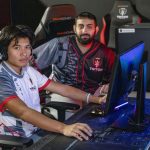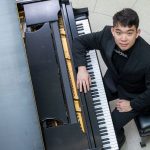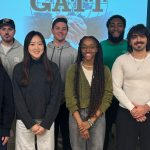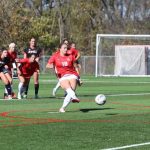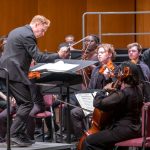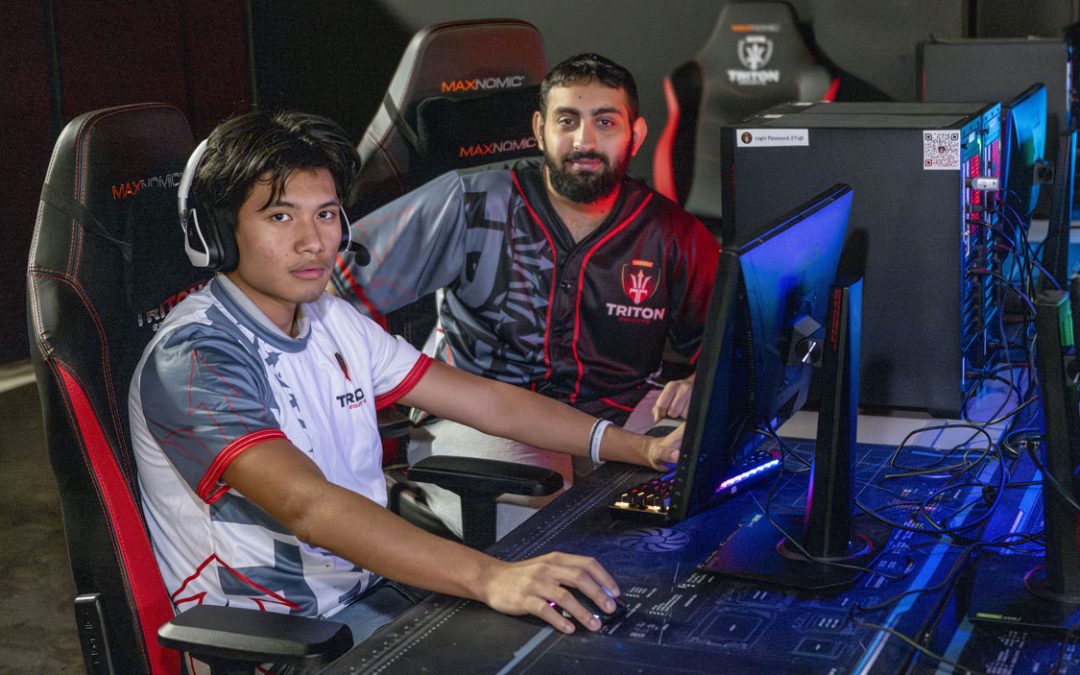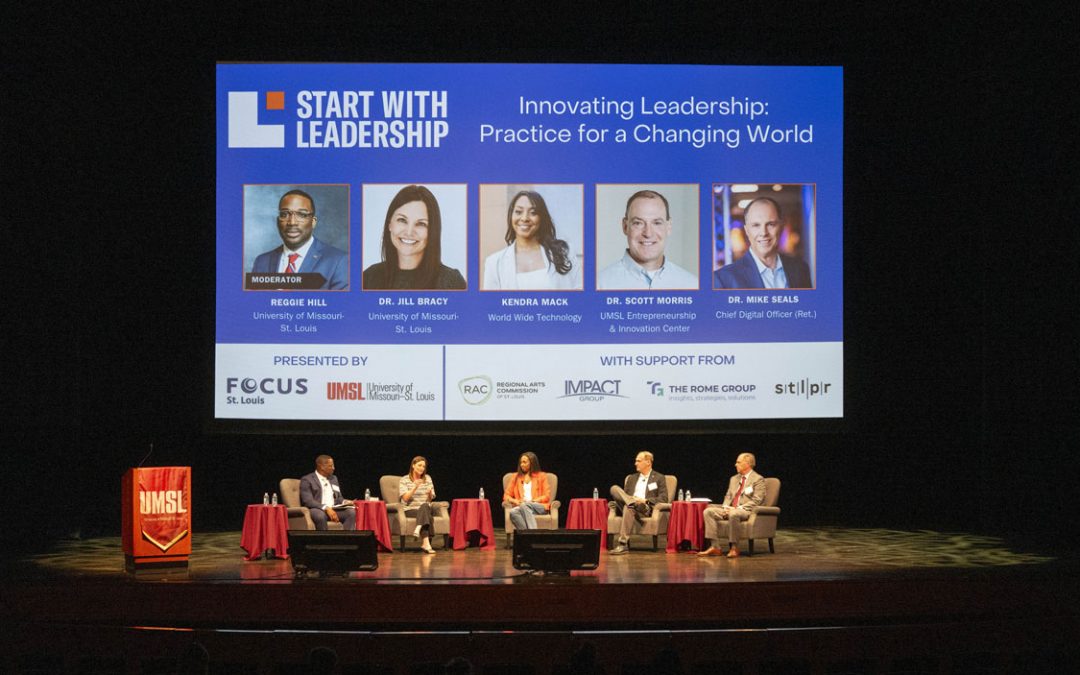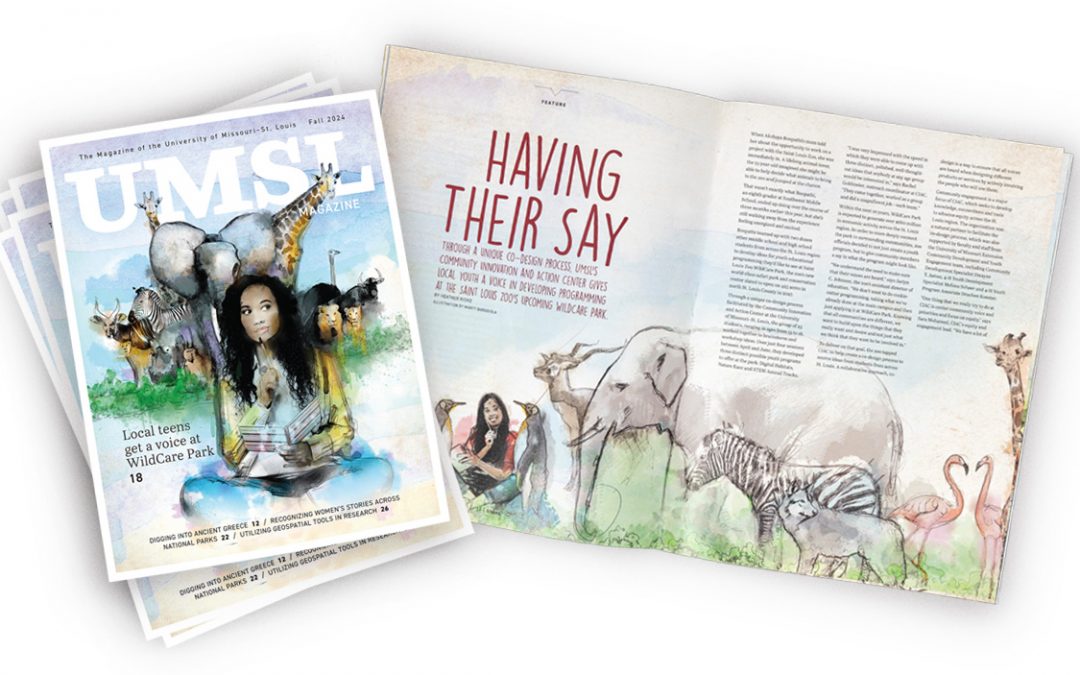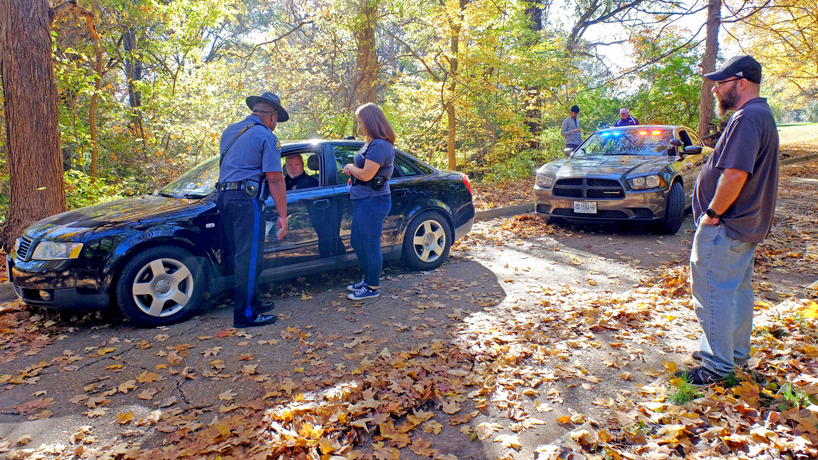
Sophomore Edie Hammett, center, took a turn playing the role of a state trooper and pulling over a car during a mock traffic stop on Friday on UMSL’s South Campus. Members of the Missouri State Highway Patrol, including Ben Jones, left, and Scott Miller, in the car, talked students through calculations they make during traffic stops. (Photo by August Jennewein)
The couple followed their dog cautiously up the road leading toward the Daughters of Charity Cemetery at the end of East Drive on the edge of the University of Missouri–St. Louis’ South Campus.
They almost certainly were wondering if they’d just stumbled upon a crime scene as they peered ahead at two Missouri State Highway Patrol cars parked with their lights flashing early Friday afternoon.
“Are we OK to go this way?” the man asked.
One of the troopers, Scott Miller, quickly put them at ease and encouraged them to continue on their lunchtime stroll.
It wasn’t an investigation that brought Miller and his colleagues to campus on a brilliant autumn day. Rather, they were running members of the Criminology and Criminal Justice Undergraduate Student Association through a series of mock traffic stops, and after roughly two hours, they were just about to wrap up.
The role-playing exercise gave students a chance to strap on a belt, complete with training weapon and handcuffs, and experience what life can be like in uniform when you never know what will greet you on the side of the highway.
“A lot of times I think people, we watch Cops, we watch these police TV shows, and it looks sexy,” said Sergeant Robert Parr, who regularly leads activities like Friday’s for student groups – both college and high school – in his role as a recruiter in the Highway Patrol’s Career Recruitment Division. “People think, ‘Hey, I want to wear this uniform. I want to drive fast, and I want to do this stuff.’ But the generic traffic stop is probably the most dangerous thing in law enforcement.”
The danger begins just being on the side of the roadway with cars and trucks zipping by at high rates of speed. Making sure officers keep themselves clear of oncoming traffic is just the first thing they have to be concerned about when they approach a vehicle they’ve pulled over.
They’re also immediately surveying what’s inside. How many passengers are there? Do they seem to be moving around or hiding anything? Are there any weapons present?
Troopers also make it a point to make sure they can see people’s hands so they can mitigate the risk of potential threats.
The students were tested to do all of that while remaining calm, composed and professional through their interactions with the troopers, who were playing the part of stopped motorists.
They were friendly at first, kindly handing over their driver’s licenses and vehicle registration when asked and politely accepting tickets.
But with each new scenario, they got a little surlier and less compliant with officer instructions.
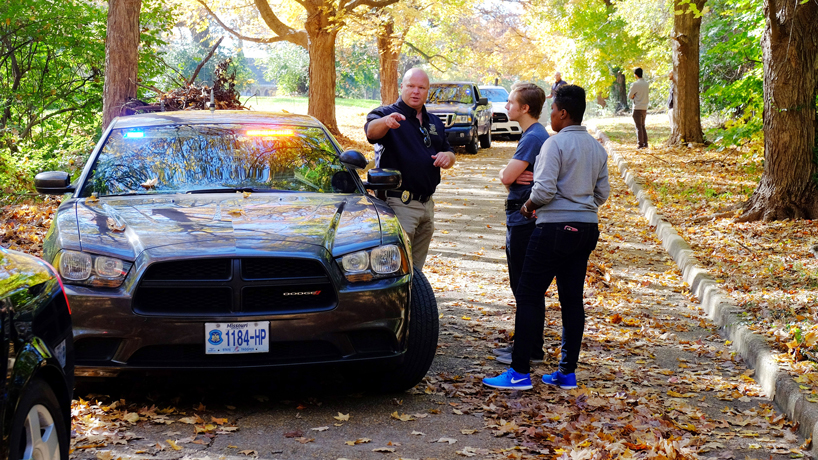
Trooper Scott Miller talks to criminology and criminal justice students Sherman Brawner, center, and Marcella Hamilton, right, during a series of mock traffic stops students conducted Friday with members of the Missouri State Highway Patrol. (Photo by August Jennewein)
Later, they introduced weapons into the exercises, reminding students not to overreact to the presence of a gun because simply having a concealed weapon is not a crime in the state of Missouri.
“It’s different than I thought,” said Edie Hammett, a sophomore member of CCJUSA. “It’s not just like I have to get your license and registration. I have to assess if your hands are on the wheel and if you have weapons. I have to watch traffic, which like I don’t know why people would even come close to hitting a police officer. I don’t know how that’s a reality.”
“It’s definitely enlightening to see how cautious they have to be and how they have to approach every situation with such extreme caution just in case because they never know what’s going to be there,” said Sherman Brawner, a senior and the current president of CCJUSA. “They have a lot to think about too whenever they’re going out to a vehicle. There’s all body positioning types of things and trying to talk to you while they’re scanning the vehicle. They’re doing a lot of stuff.”
Having perspective from both sides can be valuable at a time of heightened tension between Americans and law enforcement after several traffic-related interactions in the past year turned violent, including two that resulted in police-involved shootings in Minnesota and Oklahoma and made national headlines.
Before they headed out to East Drive, the troopers met with the students and faculty members Tim Maher and Terrance J. Taylor from the Department of Criminology and Criminal Justice in the lobby of Oak Hall, where they went over the use of force continuum, which covers how to escalate and deescalate the use of force by officers as situations dictate.
It has six levels, beginning with officer presence and rising all the way to the use of deadly force. In between are tactical communication, the use of soft hands to direct individuals, hard hands for less compliant people and the use of tools such as guns or pepper spray.
In the academy, troopers spend an entire week running through different scenarios and upping the ante one day at a time. Lieutenant Ben Jones said it took him three years of doing traffic stops before he felt confident he could adapt and handle any situation he might find on the side of a highway.
So it wasn’t surprising when the students had missteps during the course of increasingly more challenging stops.
But Parr hopes there is value to participating in the exercises, whether students aspire to be law enforcement officers, as Brawner does, or not, like Hammett, who would like to one day work for the Division of Youth Services.
“What it hopefully presents is that every traffic stop is different,” Parr said. “Every traffic stop presents a risk for the officer, and we just want them to see it through our eyes how quickly things can change.
“At the end of the day, we hope for positive and safe interaction with law enforcement. If they’re stopped again, they may not agree with the ticket for whatever reason, but at the end of the day, they’ll do what they’re asked and be polite, and the officer will certainly be polite and respectful back, and that will be a successful interaction. That’s the goal.”



